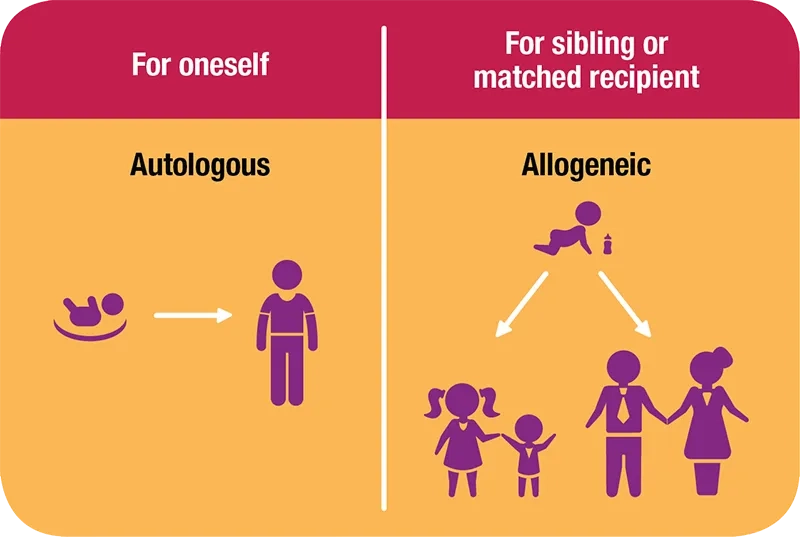
More stored stem cells, more medical treatment options for your family.
Aside from cord blood and cord tissue, save your baby’s cord lining as well because it contains two types of stem cells that can provide extra protection for your family.
What makes your baby’s umbilical cord lining unique?
From medical waste to a valuable resource containing potentially life-saving stem cells.
The umbilical cord is usually cut after the baby is born and discarded with the placenta as medical waste until researchers discovered its medical potential. The umbilical cord contains cord blood, cord tissue or Wharton’s jelly, and other components, and it’s protected by a sheet-like membrane called the cord lining. Cord lining has two types of stem cells: mesenchymal stem cells (MSCs) and cord lining epithelial stem cells (CLEpSCs).

Immense potential to repair and heal our body
Mesenchymal stem cells and epithelial cells have the potential to repair and heal the body in ways that cord blood does not. These cells have demonstrated immense capability in the repair of injured tissues and organs, as well as in the treatment of various diseases.
Mesenchymal stem cells
Mesenchymal stem cells have the ability to self-renew and differentiate into:
- Bone cells
- Cartilage cells
- Heart cells
- Muscle cells
- Nerve cells
- Pancreatic cells
- Fat cells
Cord lining epithelial stem cells
Epithelial cells are multipotent cells with the ability to differentiate into:
- Pancreatogenic cells
- Keratogenic cells
- Corneal cells
- Hepatocyte-like cells
Potential Applications Around the World1
More than 1000 clinical trials are now ongoing to uncover the potential applications of the stem cells from your baby’s umbilical cord. Please visit clinicaltrials.gov for the complete list.
Mesenchymal stem cells applications
(more than 800 clinical trials2)
Tissue repair
- Stroke
- Cardiovascular diseases
- Neurodegenerative diseases
(Alzheimer’s Disease and Parkinson’s Disease)
Immune modulation or reconstruction
- HIV
- Diabetes (type 1 and 2)
- Prevention and treatment of graft vs host disease
- Crohn disease
- Autism, Cerebral Palsy, and Global Developmental Delay
- Spinal cord injury
- Orthopedic indications
(e.g. osteoarthritis, cartilage and tendor repair, etc) - Liver regeneration from liver failure
HSCs engraftment support
- Shorten time of engraftment
- Reduce immune system complications
Epithelial cells and epithelial stem cells applications
(more than 200 clinical trials3 )
Wounds and soft tissue repair
- Surface ulcers (e.g. diabetic ulcer)
- Disorder of upper respiratory system (e.g. bronchial epithelium repair for smokers)
- Various types of burn
- Tissue trauma
- Skin wounds
- Epidermal reconstitution
Eye condtions
- Corneal ulcers and other corneal related indications
- Dry eye syndrome
- Eye injuries
- Limbal deficiency
- Macular degenerative diseases
- Aged-related myopia
- Ocular surface disease
Others
- Ischemic stroke
- Persistent corneal epithelial defect
1 The conditions listed here may be under research using stem cells from other sources other than cord tissue and cord lining.
2 NIH U.S. National Library of Medicine. www.clinical trials.gov. Search term used “mesenchymal stem cells”. Last accessed February 06, 2023.
3 NIH U.S. National Library of Medicine. www.clinical trials.gov. Search term used “epithelial stem cells”. Last accessed February 06, 2023.
Conditions in clinical trials
The table below lists some of the conditions that are currently being researched or have previously been studied in clinical trials using mesenchymal stem cells or umbilical cord lining-derived epithelial cells as interventions. As clinical research continues to take place around the world, some of these trials may advance to become the new standard of care for these conditions. Please visit clinicaltrials.gov for the complete list.
Mesenchymal Stem Cell trials
TISSUE REPAIR
- Stroke
- Heart failure
- Alzheimer’s disease
- Parkinson’s disease
- Spinal cord injury
- Orthopaedic indications
(bone, cartilage, tendon repair) - Liver failure
NEUROLOGICAL & DEVELOPMENTAL
AUTOIMMUNE OR IMMUNE MODULATION
TRANSPLANTATION SUPPORT
- Shorten engraftment time of blood-forming cells
- Reduce immune system complications
OTHERS
Cord Lining Epithelial Stem Cell trials
Who can use your baby’s cord lining?
Your baby’s cord lining stem cells could potentially be used on your entire family because they have immune-modulating properties that make them immune-privileged. Over the last decade, more than 55,000 publications on MSCs have been published, demonstrating their unique properties.1
1.Pittenger MF, Discher D, Péault BM, Phinney DG, Mesenchymal stem cell perspective: cell biology to clinical progress. Regen. Med. 2019;4(1):22.

Why you should consider umbilical cord lining banking for your baby

Umbilical cord lining stem cells have immune-modulating characteristics. Therefore matching of stem cells between donor and the patient may not be required, which makes them useful both for your baby and other members in the family.

Umbilical cord lining stem cells can also help increase the success rate of stem cell transplant. It contains two types of stem cells – Mesenchymal (MSCs) and Epithelial (EpSCs) Stem Cells, which can be used to support multiple medical treatments whenever needed.

With umbilical cord lining stem cells, your baby and family members will have more treatment options in the future, especially for disorders* that are incurable today such as stroke and heart attack.

Compared to other sources such as bone marrow and adipose tissue, stem cells from umbilical cord lining are younger with better expansion capacity and patients receiving such as stem cells have lower risk of graft versus host disease.

Using cryogenic storage method, umbilical cord lining can remain viable for a long time. This means that the therapeutic value of umbilical cord lining stem cells are well-preserved until the need for treatment arises.

Your baby has one chance to have his/her umbilical cord lining collected as this painless and harmless process must be done at birth.



